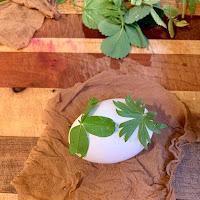May Art Blog 2015
Kindergarten: Self Portraits inspired by Frida Kahlo
Frida Kahlo (1907-1954), the artist who painted herself is Mexico's most famous female artist. She painted her self portraits in bright colors, with ribbons and flowers through her thick black braids. She liked to wear her eyebrow to look like the wings of a bird. Frida never smiled in her paintings because she was often in pain. When she was eighteen she was badly hurt in a terrible bus accident. For the rest of her life she suffered from complications from her injuries and often captured her pain and suffering in her paintings. In1929 Frida married the famous artist Diego Rivera. Due to her injuries Frida had to spend a lot of time staying in bed. To pass time she painted. Frida suggested, "I paint myself because I am so often alone and because I am the subject I know best." She had big mirror installed in the canopy over her bed. Frida could look up and see her face.
Kindergarten students were intrigued by Frida's story. Students were excited to use mirrors and draw themselves from observation, and to learn about basic facial proportions. Students had a choice to include a favorite animal in their self portraits. Just like Frida who often depicted herself with her favorite animals, birds and monkeys. Students painted their self portraits in a multi-media technique, combining bright hues of watercolor, water soluble oil pastels, and colored pencils.
Kindergarten students were intrigued by Frida's story. Students were excited to use mirrors and draw themselves from observation, and to learn about basic facial proportions. Students had a choice to include a favorite animal in their self portraits. Just like Frida who often depicted herself with her favorite animals, birds and monkeys. Students painted their self portraits in a multi-media technique, combining bright hues of watercolor, water soluble oil pastels, and colored pencils.
1st GRADE: Water Melon Composition
First grade students worked with a subject inspired by the upcoming summer break. Students incorporated skills they have studied previously: "How to create an interesting composition?" Students experimented with overlapping and cropping watermelon slices to compose the most interesting picture. To achieve texture in the background areas of their paintings, students used a watercolor/salt technique. The watermelon slices were painted with water soluble oil pastels. Students applied the bright colored oil pastels on the watermelon slices and blended their hues with brushes or their fingers. The watermelon slices look so realistic you feel like you want to bite into the juicy fruit.
2nd GRADE: Balancing Sculpture inspired by A. Calder
The second grade students created sculptures made out of wood and wire. Constructing a mobile was a study in balance and engineering, making a connection to the second grade science curriculum “balance and motion”, as well as an introduction to the American sculptor and artist, Alexander Calder,
Born into a family of artists, Calder created his first sculpture at age four. In his career, Calder created many sculptures, mobiles and stabiles, paintings, jewelry and significant toys. A fascination with the circus led to toy circuses made from wire, string, rubber and found objects, which in turn evolved into wire sculptures, and kinetic art. Calder’s keen eye for balance in his sculptures both large and small, ultimately resulted in the first “mobiles”. His first public commission was a pair of mobiles in the Berkshire Museum in Pittsfield, Massachusetts, in 1937.
3rd GRADE: Flowers inspired by Georgia O'Keeffe
Born in Wisconsin 1887, USA O'Keeffe first came to the
attention of the New York art community in 1916. She is one of the twentieth century's greatest painters. She is renowned for her images of gigantic flowers, vibrant cityscape's, and distinctive desert scenes.O'Keeffe has been recognized as the "Mother of American Modernism".
Students observed flowers from nature and from photographs. Students recognized geometric and symmetric shapes in flower petals. Each third grade student selected a type of flower for his/her subject. From a small thumbnail sketch students learned to enlarge their subject to draw onto a piece of 9"X12" color construction paper. Students cut around the contour line of their flowers and pasted the flowers onto a contrasting background paper. With soft pastels, students painted the color nuances of light, medium, and dark hues of their flowers. To achieve a realistic, three-dimensional look students included drop shadows (cast shadows) in their work.
4th GRADE: Soft Sculptures
Soft
sculpture is a type of sculpture made using cloth, foam, rubber, plastic,
paper, fibers and similar material that are supple and not rigid. They
can also be made out of natural materials if combined to make a none rigid
object. Soft
sculpture art is very popular in Japan with artists like Yayoi Kusama boosting the heritage of this new and
innovative medium for interior design. Popularized
in the 1960s by artists such as Claes Oldenburg with his props and objects Oldenburg created for performances.
Fourth grade students sketched ideas for their own, original, cute soft sculpture "aka stuffies". They learned to revise their sketches to make a pattern. Some students made asymmetrical designs, some folded their papers in half to make their designs symmetrical. Students leaned to add a 1/4 inch seam allowance to their patterns to allow enough space for stitching. Students were introduce to sewing 101: needle threading, knot tying, the basics of stitching: running stitch, whipstitch, blanket stitch, and sew on a button. Based on their sewing skill levels students chose a stitch to fit their skills. Students gently pushed Acrylic fiberfill into their soft sculptures. Students appliqued faces and other features and sewed on buttons for eyes.
We are a "maker culture"! Students enjoyed this maker project, the process from creating a pattern to the finished piece. It was engaging to boys and girls alike because persistence was required to solve problems as they occurred. Students helped each other, which made this a nice teamwork project.


















Comments
Post a Comment